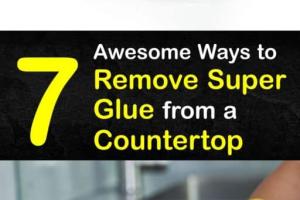Ultimate Guide: How to Remove Glue from Counter Tops Safely and Effectively

-
Quick Links:
- Introduction
- Understanding Different Types of Glue
- Essential Tools and Materials
- Step-by-Step Guide to Remove Glue
- Case Studies and Real-World Examples
- Expert Insights
- Safety Tips
- Preventive Measures
- FAQs
Introduction
Glue stains can be a frustrating issue when it comes to maintaining your countertops. Whether you’re dealing with a spilled craft adhesive, leftover epoxy from a project, or residue from stickers, knowing how to effectively remove glue without damaging your countertop surface is essential. In this comprehensive guide, we will explore various methods, tools, and tips for removing glue safely and effectively.
Understanding Different Types of Glue
Before diving into the removal methods, it’s crucial to understand the type of glue you’re dealing with. Here are some common types:
- PVA Glue: Often used in woodworking, can be cleaned with warm water.
- Super Glue: A cyanoacrylate adhesive that bonds quickly and strongly.
- Hot Glue: Typically used in crafts, can be softened with heat.
- Epoxy: Known for durability, requiring solvents for removal.
- Contact Cement: Creates a strong bond and may require scraping.
Essential Tools and Materials
Having the right tools can make all the difference. Here are the materials you will need:
- Rubbing alcohol or acetone
- Plastic scraper or putty knife
- Warm water and soap
- Heat gun or hairdryer
- Cotton balls or soft cloths
- Commercial adhesive remover (optional)
- Protective gloves
Step-by-Step Guide to Remove Glue
Here is a detailed procedure for removing glue from your countertops:
Step 1: Identify the Glue Type
Before starting, determine what type of glue you are dealing with to choose the most effective removal method.
Step 2: Test a Small Area
Always test your chosen removal method on a small, inconspicuous area to ensure it doesn’t damage the surface.
Step 3: Use the Appropriate Method
- PVA Glue: Soak a cloth in warm soapy water, place it on the glue, and leave for 10 minutes. Wipe clean.
- Super Glue: Use acetone on a cotton ball and apply it to the glue. Let it sit for a few minutes before scraping.
- Hot Glue: Use a heat gun or hairdryer to soften the glue, then gently scrape it off.
- Epoxy: Apply a commercial adhesive remover, let it sit, and then scrape off.
- Contact Cement: Carefully scrape with a plastic scraper, and if needed, use a solvent.
Step 4: Clean the Area
After the glue has been removed, clean the area with soap and water to remove any residue from the adhesive or solvents.
Step 5: Dry and Inspect
Dry the surface thoroughly and inspect for any remaining glue or damage.
Case Studies and Real-World Examples
Many homeowners have successfully dealt with glue removal. Here are a few case studies:
- Case Study 1: A kitchen renovation where epoxy glue was removed using a combination of heat and scraping.
- Case Study 2: Removing craft glue from a laminate surface using warm soapy water successfully.
Expert Insights
We consulted with cleaning experts and home improvement specialists to gather their top tips:
- Always wear gloves when using chemicals.
- Be patient; some adhesives take time to dissolve.
- Consider the surface material; some methods may not be suitable for all countertops.
Safety Tips
- Work in a well-ventilated area when using solvents.
- Wear protective gear like gloves and goggles when necessary.
- Keep children and pets away from the work area.
Preventive Measures
To avoid future glue disasters:
- Use cutting boards or mats for crafting projects.
- Clean spills immediately to prevent hardening.
- Seal countertops with a protective finish if applicable.
FAQs
1. What is the best way to remove super glue?
Use acetone or nail polish remover on a cotton ball, apply it to the glue, and scrape it off after a few minutes.
2. Can I use vinegar to remove glue?
Vinegar can help, especially for PVA glue. Soak a cloth in vinegar and place it on the glue for a few minutes.
3. Will heat damage my countertop?
Always use a heat setting that is appropriate for your countertop material to avoid damage.
4. How long does glue removal take?
It varies by glue type; some may take just minutes, while others might require more time to soak or dissolve.
5. Is it safe to use commercial adhesive removers?
Yes, but be sure to follow the manufacturer's instructions and test on a small area first.
6. Can I remove glue from stone countertops?
Yes, but use caution and consult with a specialist if you are unsure about the method.
7. What if the glue leaves a stain?
Try polishing the area or using a specialized stone cleaner if the glue leaves a stain after removal.
8. Are there natural alternatives to chemical glue removers?
Yes, options like baking soda, vinegar, and warm soapy water can be effective for certain types of glue.
9. How do I prevent glue from sticking to my countertops?
Use protective mats or surfaces when working with adhesives to prevent spills and stains.
10. Can I use a razor blade to scrape off glue?
Only if you are very careful and ensure it won't scratch the surface; a plastic scraper is usually safer.
Random Reads
- How to repair wicker furniture
- How to print text messages from iphone
- Manual reset wifi adapter windows
- Master mcdonalds video game
- How to remove rust from chrome
- Powerpoint transitions
- Mastering image import in photoshop
- How to remove paper label plastic prescription bottle
- How to remove paint from skin
- How to hang heavy mirror